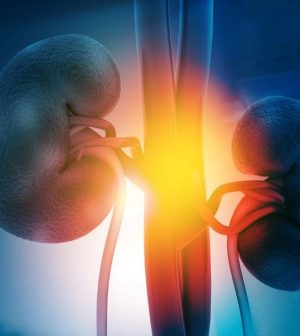- Navigating Your Midlife Crisis: Embracing New Possibilities
- City Raccoons Showing Signs of Domestication
- Mapping the Exposome: Science Broadens Focus to Environmental Disease Triggers
- One Week Less on Social Media Linked to Better Mental Health
- Your Brain Changes in Stages as You Age, Study Finds
- Some Suicide Victims Show No Typical Warning Signs, Study Finds
- ByHeart Formula Faces Lawsuits After Babies Sickened With Botulism
- Switch to Vegan Diet Could Cut Your Greenhouse Gas Emissions in Half
- Regular Bedtime Does Wonders for Blood Pressure
- Dining Alone Could Mean Worse Nutrition for Seniors
It’s Safer to Donate a Kidney Now Than at Any Time in History

The risk of death associated with donating a kidney is at an all-time low, a new study finds.
A kidney donor’s risk — already small a decade ago — is now lower by more than half, researchers found.
Fewer than one death occurs for every 10,000 kidney donations, according to results published Aug. 28 in the Journal of the American Medical Association.
That’s much lower than the three deaths in every 10,000 donations that researchers originally predicted, based on data from 1995 through 2009.
“While we had always understood that kidney donation is safe, our findings suggest that mortality among donors is extremely rare, and the procedure is safer than ever before,” said lead researcher Allan Massie, director of the NYU Grossman School of Medicine’s Center for Surgical and Transplant Applied Research Quantitative Core.
Each year, roughly 6,000 Americans volunteer to donate a kidney, according to the Organ Procurement and Transplantation Network.
Analyzing medical records for nearly 165,000 U.S. kidney donors, researchers found that a total 36 deaths had occurred over 30 years.
There have been five donors who died within 90 days of their surgery since 2013, compared with 18 who died between 2003 and 2012 and 13 earlier than 2003.
About half of the deaths occurred within the first week after donation, most commonly due to blood loss from the surgery, results show.
Donors who were male and those with a history of high blood pressure were more likely to die soon after surgery, researchers found.
Improved surgical methods are most likely the reason why survival is even higher now among kidney donors, researchers said.
For example, kidneys are now removed through less invasive laparoscopic surgery, which uses a much smaller incision. In the past, a 6-inch to 8-inch incision was needed to remove a kidney.
Doctors also are better at taking care of donors following their surgery, and at making sure donors are healthy enough to safely give up one of their kidneys, researchers said.
“These results demonstrate that the current guidelines used to inform potential kidney donors of their risks need to be updated to reflect nearly a decade of safety improvements,” said senior study author Dr. Dorry Segev, vice chair of surgery at NYU Grossman School of Medicine in New York City.
One of the researchers, Macey Levan, is also one of the statistics. She donated her kidney to her cousin in 2009.
“As a kidney donor and research scientist in the field, it is reassuring to see the progress we have made,” Levan, an associate professor of surgery and population health at NYU Grossman School of Medicine, said in an NYU news release.
More information
The American Kidney Fund has more on the risks of kidney donation.
SOURCE: NYU Grossman School of Medicine, news release, Aug. 28, 2024
Source: HealthDay
Copyright © 2025 HealthDay. All rights reserved.










